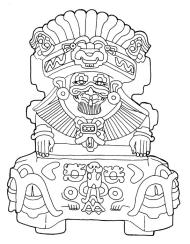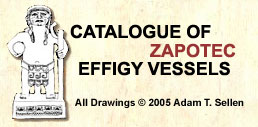| Key: MCO 2702 | | Actual Location: Museum of Cultures of Oaxaca, City of Oaxaca, Mexico (exhibited). | | Registration: 2702 | | Provenance: In front of the entrance to tomb 7, Monte Albán, Oaxaca. | | Chronology: Xoo 600 - 800 AD | | Click to view Chronology | | Reference: Caso 1932a: 19-20, fig. 32; Caso 1932b: 466-467; Caso & Bernal 1952: 44, figs. a, b, c; Bernal 1979: 144, fig. 52. | | Comments: This piece was found flanked by two pieces of lid and box, but the lids of the other two pieces are different, as they represent the Cocijo. Caso and Bernal identified the human figure of the illustrated urn as "The God of Corn" (1952: 46). The three pieces were found broken and, according to Caso (1932: 20), the position of the two fragments proves that the break was intentional and that, after doing so, the objects were buried. Caso excavated tomb 7 in the first PMA I period (1931-1932). | | Glyphs: Glyph C in the headdress flanked by two ears of corn. | |
| | 
Click to view high resolution in a new window
select this image for review |
